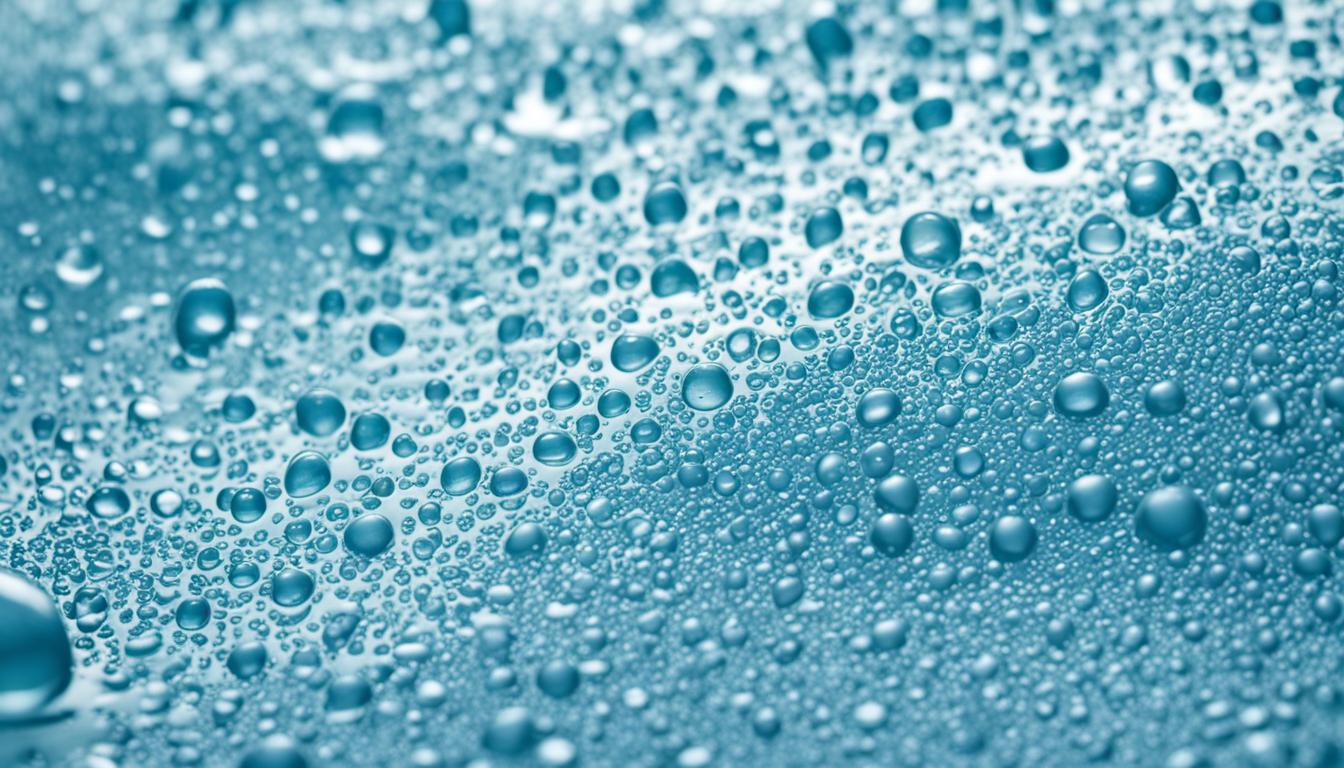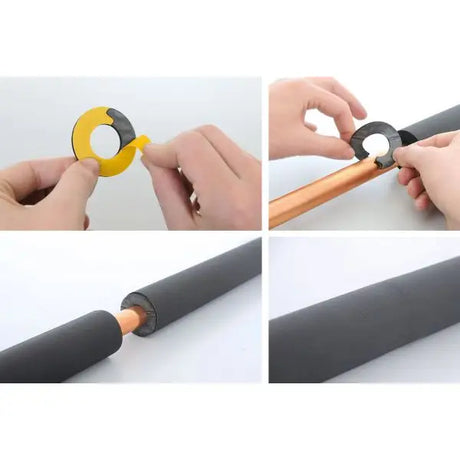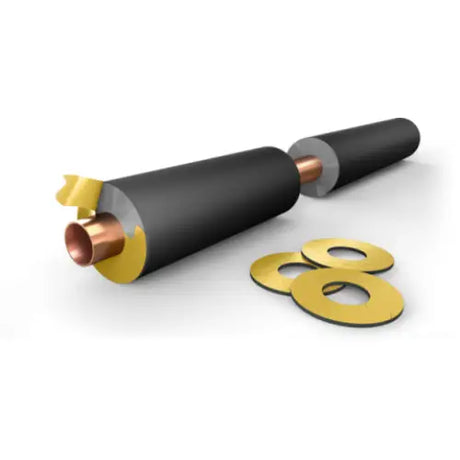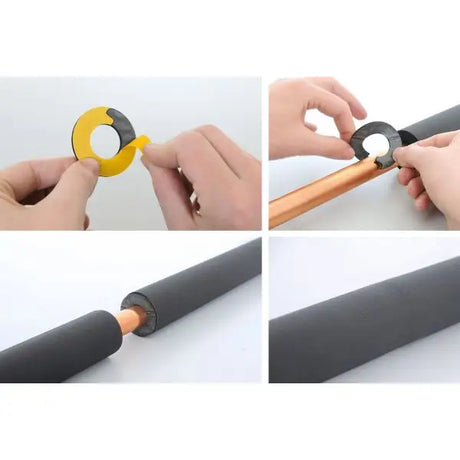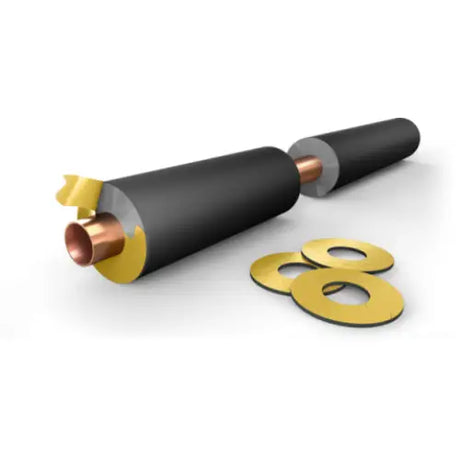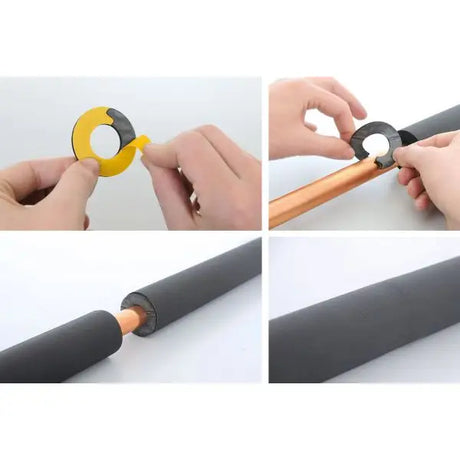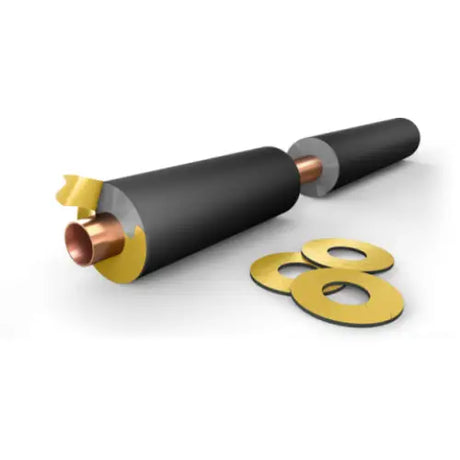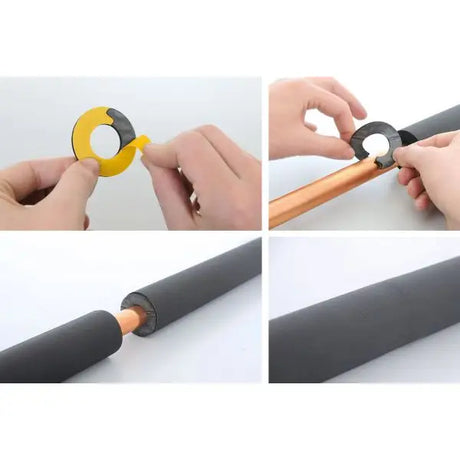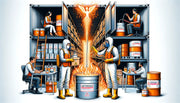Do we sometimes overlook moisture management in building insulation? It's crucial for keeping a building stable and energy-efficient. Inside elastomeric foam, this task is essential. This material is changing how we think about construction and insulation.
Elastomeric foam is great at handling water vapor. It protects against moisture damage well. This not only helps with insulation. It also makes buildings last longer, saves money, and reduces their environmental impact. There's a fine line between letting a building breathe and blocking water vapor. Elastomeric foam walks this line beautifully.
Choosing eco-friendly materials is key today. Elastomeric foam is flexible, tough, and controls moisture. This opens up new ways to safeguard and enhance our homes and workplaces.
Key Takeaways
- Understanding elastomeric foam's superior control over water vapor permeability.
- Comprehending the balance between air flow and barrier protection in insulation choices.
- Exploring the cost-effectiveness and environmental benefits of elastomeric foam insulation.
- Realising the breadth of applications for elastomeric foam beyond conventional insulation.
- Embracing technological advancement as a bridge to sustainable development.
Introduction to Elastomeric Foam Insulation
Understanding elastomeric foam insulation is crucial for those in construction and insulation. This material is known for its excellent thermal efficiency and flexibility. In the last 20 years, its popularity has grown due to higher indoor air quality standards and support from IAQ advocates1. Made from synthetic rubber, elastomeric foam comes in tubes, sheets, or rolls. This makes it ideal for many construction projects2.
This insulation avoids formaldehyde or fibres, making it safer for health and the environment. It also emits low levels of VOCs, which is better for the planet. Plus, it's lightweight, which is good for building design1.
New developments, like non-halogen foam for high temperatures, have made elastomeric foam more popular. Companies like Armacell and Aeroflex USA, Inc. are leading the way with new products and acquisitions1.
The market for elastomeric foam insulation is divided into different types, like thermal and acoustic. It's used all over the world, in places like Europe and Asia-Pacific. The COVID-19 pandemic has shown the importance of strong supply chains1.
"Elastomeric foam insulation is very important in HVAC and plumbing. It helps create energy-efficient and comfortable homes for the future."1
Even though more people want this insulation, high costs and little awareness slow its growth. Industry leaders need to make its benefits more known. This will help it be used in more areas1.
Market reports give valuable information about trends and the roles of buyers and suppliers. They help businesses and investors make better decisions1.
| Property | Benefit to Construction |
|---|---|
| Thermal Efficiency | Reduces energy usage, enhancing building sustainability. |
| Fire Protection | Increases safety standards, essential for compliance. |
| Corrosion Prevention | Extends the lifespan of the structural components. |
| Noise Reduction | Improves indoor acoustics, contributing to a quiet living space. |
When choosing insulation, think about easy installation, cost, local material availability, and if it fits well on surfaces. Elastomeric foam is often a top choice because it meets these needs and is environmentally friendly2.
Understanding the Unique Composition of Elastomeric Foams
The elastomeric foam composition is essential for many uses, especially where keeping warmth and blocking moisture matter. These foams are made mainly from nitrile butadiene rubber (NBR), ethylene-propylene-diene monomer (EPDM), and chloroprene rubber (CR). These ingredients give elastomeric foams special qualities for certain tasks3.
Elastomeric foams are great at keeping heat, as even a small increase in moisture can lower their ability to insulate4. The heat passing through these foams in the US can vary, showing they are ideal for jobs needing stable temperatures4.
These foams are also really good at stopping moisture from getting through4. With varying levels of water vapor resistance, they meet high industry standards against moisture4.
| Temperature Range (°C) | Relative Humidity (%) | Thermal Efficiency Loss at 1% Moisture Increase (%) |
|---|---|---|
| Over 26 | 73 and higher | 7.5 |
| 24–26 | 62–72 | |
| 21–24 | 52–61 | |
| 18–21 | 44–51 | |
| 16–18 | 37–43 | |
| 13–16 | 31–36 | |
| 10–12 | 26–30 | |
| Under 10 | 25 and lower |
Many external factors like the roofing system's design and quality affect how well elastomeric foam membranes work3. Studies by the National Bureau of Standards have shown how effective these materials are3. These materials are great for both new and repair projects, showing their wide use3.
The importance of elastomeric foam composition is clear. Its adaptable nature, moisture resistance, and ability to keep heat show why it's a top choice. This makes it ideal for ensuring buildings are sturdy and energy efficient.
The Manufacturing Process of Elastomeric Foam Insulation
The search for top-notch insulation has led to better elastomeric foam manufacturing processes. These use synthetic rubber's special traits to meet global demands. The careful creation of the end product is key. It decides the foam's features and how it can be used.
Synthetic Rubber and Its Crucial Role
At the heart of this insulation is synthetic rubber. It's chosen for its amazing stretch and toughness. Made mostly from NBR or EPDM, this rubber is a feat of chemical engineering. Its property of forming closed cells when thick offers more strength and less water soaking-in1
From Mixing to Extrusion: Shaping Elastomeric Foam
The manufacturing starts by mixing rubber with special agents and tiny fillers. This mix improves the structure and strength1. Through extrusion, it's turned into different shapes. Then, heat changes a chemical agent into gas, making air-filled cells in the foam.
Advanced Granulate Technology for Superior Quality
To get top-quality foam, modern methods use granulate technology. It makes the cell size consistent. This process also keeps the foam's insulation properties and performance high. The right amount of foaming agent ensures a better foam structure1
https://www.youtube.com/watch?v=0vXUtP9Nr0E
The final foam is a mix of science and art. It is cooled, cut, and packaged for use in important industries. From the heating and cooling industry, set to grow to over USD 312 billion by 20352, to construction with potential to hit USD 13 billion2
| Industry | 2022 Value (USD Billion) | 2035 Projected Value (USD Billion) |
|---|---|---|
| Heating and Cooling | 312 | Exceeds 312 |
| HVAC Systems | 144 | 246 |
| Automotive Insulation | 2.53 | 3.6 |
| Sustainable Insulation | 67 | 98 |
| Elastomeric Foam | 3.36 | 7.39 |
| Asia Pacific Elastomeric Foam Market | 1.26 | 2.5 |
| Construction Industry | 5.68 | Exceeds 13 |
| Global Refrigeration Systems | N/A | 170 |
Elastomeric foam manufacturing is at the heart of innovation, driven by industry data and forecasts. It's key for providing top thermal and acoustic insulation around the globe.
Characteristic Properties of Elastomeric Foam Insulation
In the world of insulation, elastomeric foam properties stand out for being top-notch. They play a big role in sectors like HVAC, automotive, and construction. These sectors are growing fast, thanks to the material's great performance.
The heating and cooling industry, which relies on elastomeric foam, is booming. It's expected to be worth more than USD 312 billion by 20355. The HVAC market alone, using a lot of this foam, was worth over USD 144 billion in 2022. By 2035, it might reach USD 246 billion, showing how important this material is5.
Elastomeric foam is loved for its thermal insulation, low thermal conductivity, and resistance to moisture absorption. Its benefits are critical in many tough insulation cases. The Asia Pacific is a big market for this foam, having a size of USD 1.26 billion in 2022. It's expected to grow big, reaching over USD 2.5 billion by 20355. This growth is due to a yearly increase rate of 6.17%, taking its value from US$3.294 billion in 2020 to US$5.008 billion by 20276.
To ensure elastomeric foam's quality, it's tested using the ASTM D1056 standard. This checks how much it can be squished. The closed-cell type is really good at not soaking up water, gas, or oil7. This type of foam also has a 'skin' to stop water vapor from passing through, measured in 'perms'7.
| Property | Description | Impact |
|---|---|---|
| Thermal Insulation | Reduces heat transfer | Contributes to energy conservation and sustainability |
| Low Thermal Conductivity | Minimizes temperature fluctuations | Enhances comfort and process control in HVAC applications |
| Moisture Resistance | Impedes water vapor transmission | Prevents mould growth and corrosion |
| Flexibility | Allows for easy manipulation and fitting around varied shapes | Improves ease of installation and reduces wastage |
| Lightweight | Easy to handle and transport | Favourable for reducing structural load in construction |
Since 2008, Worldwide Foam has played a big role by providing top-quality foam. They offer services like heat lamination and skiving with a quick one-day lead time. Their operations are spread across seven key locations7.
As the demand and uses for elastomeric foam grow, it remains a leading choice in insulation. It's perfect for many sectors, like automotive and aerospace, because of its flexibility7.
The HVAC area shows how reliable elastomeric foam is, expecting big growth soon. EPDM is also set to take a big market share, thanks to its wide use. By looking at these market trends and uses, elastomeric foam proves itself as an excellent insulation choice. This positions it well for a sustainable and efficient future.
Water Vapor Permeability Elastomeric Foam: An Overview
In insulation, elastomeric foam water vapor permeability plays a big part in controlling moisture. It not only improves insulation efficiency but also keeps the area dry. This helps prevent problems caused by too much moisture.
What is Water Vapor Permeability?
Water vapor permeability measures how well moisture can pass through a material. For insulation, the right level of permeability is key. It stops moisture problems like mold and building damage while allowing air and temperature to be managed well.
How Elastomeric Foam Manages Moisture
Elastomeric foam, with its special structure, tackles moisture effectively. It acts like a shield against condensation. When moisture meets this foam, its features create a barrier. This limits the amount of moisture getting in and protects the structure around it.
It's important to know how this works. This knowledge benefits those in construction and insulation. It also helps anyone looking to reduce energy use and make buildings last longer.
| Elastomeric Foam Property | Role in Moisture Management | Benefits |
|---|---|---|
| Low Water Absorption | Repels moisture at the surface level | Prevents mould growth and structural damage |
| High Water Vapor Resistance | Modulates diffusion of water vapor | Reduces condensation and associated energy loss |
| Air Tightness | Limits uncontrolled air/moisture flow | Enhances thermal efficiency and indoor air quality |
This table shows how elastomeric foam stops moisture in insulated areas. It underscores its key role in moisture control.
The Significance of Water Vapor Barrier Elastomeric Foam
Water vapor barrier elastomeric foam is at the cutting edge of insulation technology, offering a vital defence against moisture. It has a permeability rating as low as .016 perm with 10 mils/min. of coating. This makes it an impermeable choice8 designed to shield buildings from the harm caused by water vapor.

The success of insulation materials relies heavily on their ability to block moisture vapor. This is measured in either g/m2·day or g/100in2·day8. In British homes, where staying warm is essential, placing these barriers inside is key to controlling condensation8. However, in places that need more cooling, the barriers are placed outside, showing the foam's flexibility in different climates.
These barriers come in three types: Impermeable, Semi-permeable, and Permeable, based on their perm ratings89. For example, Advanced Polyethylene vapor retarders meet the ASTM E 1745 standard. They offer less than 0.3 US perm, making them ideal for careful use8.
In modern building rules, vapor barriers are a requirement, not just a suggestion, in places like the U.S., Canada, and the UK8. They are crucial in damp-prone areas like basements. In existing homes, special paints help protect against vapor9.
The use of water vapor barrier elastomeric foam is not just about controlling temperature and saving energy. It also helps maintain a building's structure. By preventing corrosion and decay caused by dampness, elastomeric foam keeps buildings strong against time and weather.
Advantages of High Vapor Permeability Elastomeric Foam
High vapor permeability elastomeric foam has changed the game in insulation. It's great at keeping long-lasting thermal performance and protecting against moisture. This makes it key in today's building and industrial work. EPDM elastomeric foams can work in temperatures from -65°F to 250°F. This range is wider than NBR foams, which work from -40F to 180F10.
EPDM stands out because of its high tensile strength, excellent aging, and abrasion resistance10. Armacell has made it even better by adding Microban®. These additives fight off mold and mildew. They set a high bar for long-term thermal performance and air quality by stopping microbes10.
Long-Term Thermal Performance Maintenance
Maintaining insulation performance over time is tough. But, high vapor permeability elastomeric foam is up to it. Its design helps with fire safety, especially EPDM in thicker sizes10. NBR and EPDM foams naturally keep out water. So, you don't need extra vapor barriers. This makes controlling thermal conductivity simpler10.
Protection Against Moisture-Related Issues
This foam is great at handling moisture problems. It stops water vapor from getting in and reduces damp risk. Not only does it make buildings last longer, but it also keeps them energy-efficient. Armacell focuses on eco-friendly products. Their insulations have GREENGUARD Gold Certification for low VOC emissions. This shows their products are reliable and frugal for any project aiming for durability and green choices10.
In summary, high vapor permeability elastomeric foam is changing insulation for the better. It's used in commercial, industrial, or residential settings. It leads to stronger, efficient, and eco-friendly insulation methods.
Elastomeric Foam for Waterproofing and Its Applications
The essential role of elastomeric foam for waterproofing is key in today's construction and industries. It is a tough material that stops water from entering buildings. This protects many structures from damage caused by moisture.
This foam is great for roofs, acting as a strong barrier against rain. It makes roofs last longer. In foundations, it stops groundwater from rising, keeping buildings stable. For places like basements and tunnels, its ability to resist moisture keeps them dry and safe.
Its flexibility is clear in many uses, offering a waterproof solution that saves money and is effective.
| Application | Benefits | Industry Examples |
|---|---|---|
| Roofing Systems | Improved longevity and resistance to elemental wear | Commercial and Residential Buildings |
| Foundation Sealant | Prevention of capillary water damage and structural degradation | Infrastructure Projects |
| Underground Waterproofing | Protection against subterranean moisture and conducive conditions for mold | Subway Systems, Basements |
The installation of elastomeric foam for waterproofing is easy and flexible. It helps build lasting structures. It provides top-notch element protection and is easy to keep up with. This makes elastomeric foam a top pick for waterproofing needs.
For new and updated projects, choosing elastomeric foam for waterproofing ensures top waterproofing and moisture resistance. Its high-tech makeup offers a solid answer to the tough waterproofing issues in today's building work.
Comparing Elastomeric Foam with Other Insulation Materials

Choosing the right insulation is crucial for your building's performance and lifespan. Key factors include resistance to mold and moisture and improving indoor air quality. Elastomeric foam insulation excels in both areas, making it a top choice over other materials.
Resistance to Mold and Moisture
Elastomeric foam's unique properties offer a strong defense against moisture. This moisture can lead to mold in buildings. Unlike fiberglass, which can soak up water, elastomeric foams have a special structure. This structure keeps water and vapor out, reducing mold risk and keeping the space clean and strong. Modern polymer foams, like those developed in 201411, have new features. These features make them ideal for insulation with low water uptake11.
Indoor Air Quality Benefits
Elastomeric foam also helps keep the air inside buildings clean. It doesn't break down and release small particles, and it stops mold spores from spreading. Other insulation might release dangerous gases or substances, but high-quality elastomeric foams don't. This makes the air safer to breathe. The growing demand for these materials, noted in market research from the 2010s, shows that people prefer insulations that protect air quality11.
| Material | Mold & Moisture Resistance | Indoor Air Quality Impact | Long-Term Durability | Energy Efficiency |
|---|---|---|---|---|
| Elastomeric Foam | High | Positive | High | Good |
| Fiberglass | Low | Potentially Negative | Medium | Variable |
| Foam Board | Medium | Potentially Negative | Medium | Good |
| Cellulose | Medium | Positive | Low | Good |
Elastomeric foams last a long time and keep their features, which saves money and improves performance. They are great at insulating, which can help reduce energy costs. Reports by Smithers Rapra say that high-performance polymer foams are a big step forward. They not only insulate well but also have low environmental impact112.
When compared to other insulations, elastomeric foam's benefits shine through. Its resistance to mold and moisture and air quality improvements make it a standout choice. It protects buildings from damage and keeps the air clean, all while helping save the planet.
The Role of Elastomeric Foam in Construction
Introduced in the 1950s, elastomeric foam insulation has changed the construction industry12. It's used in walls, roofs, HVAC systems, and pipes. This showcases its toughness and flexibility.
The foam is made from a mix of synthetic rubber, like NBR and EPDM, plus PVC12. It's eco-friendly, omitting harmful chemicals in its creation. Now, there's a global demand for it, mainly because it improves indoor air quality. It has led to new, safer foams for outdoor use too12.
Elastomeric materials protect against weather and have low VOC emissions12. They don't contain fibres or formaldehyde. This helps keep indoor air clean, a key goal in new buildings.
Recent tech advancements have improved elastomeric foam even further12. It can now withstand high temperatures. It comes in many colours and has germ-fighting properties. These features highlight its growing importance in sustainable construction.
Research into elastomeric foams is ongoing, despite certain gaps13. A notable project is exploring how these foams handle moisture. It uses a European test method, EN 13469:2012, to get more accurate results. This aims to make the findings very applicable to the construction sector13.
Investment in elastomeric foam research proves how valuable the material is1213. It's now crucial for building projects, reflecting the industry's trust in its performance.
Recent Technological Innovations in Elastomeric Foam Production
Recent progress in elastomeric foam production has been remarkable, especially for high-temperature uses and strict environmental needs. Armacell introduced ArmaFlex Ultra with FlameDefense technology, making history. It's the first flexible elastomeric foam to achieve a UL 723 classification with a 25/50 rating14. This innovation marks a significant step in creating solutions for high-temperature applications.
Enhancements for High-Temperature Applications
ArmaFlex Ultra has set a new standard. It consistently achieves 100 percent in benchmarks14. It also gained IMC third-party certification, a first for any flexible elastomeric insulation14. These improvements show the industry's effort to meet the need for materials that perform well in extreme conditions. They do so while keeping safety and effectiveness in mind.
Developments for Improved Environmental Compliance
ArmaFlex Ultra excels in water vapor permeability and thermal performance14. Its strong moisture resistance and outstanding condensation control help prevent mold, corrosion, and water damage. This makes elastomeric foam suitable for eco-friendly uses.
| Material | Thermal Conductivity | Moisture Resistance | Industrial Use |
|---|---|---|---|
| Elastomeric Foam | High | Excellent | Refrigeration, HVAC |
| PIR/PU | Low | High | Cryogenic, Refrigeration |
| Polystyrene Foam | Good | Moderate | Packaging, Construction |
| Fiberglass | Excellent | Good | Industrial, Cryogenic |
| Phenolic Foam | Good | Excellent | Fire Safety Applications |
The market for refrigeration insulation materials is on the rise. By 2032, it's expected to hit USD 6217.7 million and grow at a 5.0% CAGR15. This growth highlights elastomeric foam's increasing use in important sectors, from food and beverage to oil and gas. These industries value thermal efficiency and environmental responsibility. Thanks to new technologies in elastomeric foam, we have materials that are not just suitable for their jobs. They are also friendly to the environment, leading the way to a more sustainable future.
Conclusion
Let's conclude by highlighting a key feature of elastomeric foam - its amazing ability to let water vapour pass through. This not only boosts its insulation power but also helps control moisture. This, in turn, makes insulation last longer. We've seen how this material offers several benefits in construction and insulation. It helps save energy and makes buildings and systems work better. This is very important for taking care of our environment.
Elastomeric foam is a top choice when we talk about picking materials wisely. It's not just good for saving energy. It can also help save money and reduce carbon emissions. For example, refineries lose a lot of money every year due to bad insulation. Using elastomeric foam can solve this problem quickly and save money in the long run16.
Many places still don't use enough insulation16. This is a big problem. But, there's a strong argument for using better insulation, like elastomeric foam. Most of the time, it pays for itself in less than two years16. As we finish, everyone should see the clear benefits of using elastomeric foam. It's good for both the planet and our wallets.
FAQ
What is the water vapor permeability of elastomeric foam?
Elastomeric foam lets water vapor pass through it easily.
What is elastomeric foam insulation?
Elastomeric foam insulation is a type of synthetic rubber. It's made with a special structure that keeps heat in very well.
What is the composition of elastomeric foams?
Elastomeric foams are made from synthetic rubber mixes like NBR, EPDM, or CR. These materials make the foam flexible, long-lasting, and good at keeping out moisture.
How is elastomeric foam insulation manufactured?
To make elastomeric foam insulation, synthetic rubber is mixed and shaped. Then, it's heated, cooled down, and finally cut to size.
What are the characteristic properties of elastomeric foam insulation?
This foam is great at insulating, has low thermal conductivity, and doesn't absorb much moisture. It's also flexible, light, and easy to put in place.
What is water vapor permeability, and why is it important?
Water vapor permeability means how well a material lets water vapor through. It's key for insulation to control moisture, stop mold, and save energy.
What is the significance of water vapor barrier elastomeric foam?
Water vapor barrier elastomeric foam stops water vapor. This protects surfaces from getting wet, saves heat, and prevents rust.
What are the advantages of high vapor permeability elastomeric foam?
This kind of foam keeps its insulating power for a long time, doesn't absorb moisture, avoids mold, and handles moisture well. It's perfect for green insulation.
How is elastomeric foam used for waterproofing?
Elastomeric foam helps to waterproof roofs, foundations, and underground parts. Its ability to repel water and resist moisture stops water from getting in.
How does elastomeric foam compare to other insulation materials?
Compared to fiberglass and foam board, elastomeric foam is better at preventing mold and moisture. It's also more durable, efficient at keeping heat, and improves air quality inside.
What are the applications of elastomeric foam in construction?
In construction, elastomeric foam insulates walls, roofs, HVAC systems, and pipes. This helps buildings perform better, feel more comfortable, and be more eco-friendly.
What are the recent technological innovations in elastomeric foam production?
New tech has improved elastomeric foam for high heat, made it more eco-friendly, and introduced new colors and laminated options.
Source Links
- https://www.alliedmarketresearch.com/elastomeric-foam-market-A11805
- https://natural-resources.canada.ca/energy-efficiency/homes/make-your-home-more-energy-efficient/keeping-the-heat/chapter-3-materials/15633
- https://nvlpubs.nist.gov/nistpubs/Legacy/TN/nbstechnicalnote972.pdf
- https://www.armacell.us/fileadmin/user_upload/White_Papers/Armacell_ChilledWater.WhitePaper.EN.US.2020.pdf
- https://www.researchnester.com/blog/chemicals/advanced-materials/elastomeric-foam-new-age-insulation-material
- https://www.knowledge-sourcing.com/resources/blogs/elastomeric-foam-flexibility-is-the-key-to-stability/
- https://worldwidefoam.com/what-is-closed-cell-elastomeric-foam/
- https://en.wikipedia.org/wiki/Vapor_barrier
- https://www.energy.gov/energysaver/vapor-barriers-or-vapor-retarders
- https://www.armacell.us/en/blog/post/what-is-the-difference-between-nbrpvc-and-epdm-insulation/
- https://www.ncbi.nlm.nih.gov/pmc/articles/PMC6213201/
- https://insulation.org/io/articles/insulation-materials-closed-cell-elastomeric-foam/
- https://www.ashrae.org/file library/technical resources/research/research project bidding/g.a.-1703-trp.pdf
- https://www.prweb.com/releases/armacell-s-armaflex-r-ultra-with-flamedefense-tm-technology-becomes-first-flexible-elastomeric-foam-insulation-to-receive-ul-classified-mark-863255800.html
- https://www.businessresearchinsights.com/market-reports/refrigeration-insulation-material-market-111419
- https://insulation.org/io/category/global/material-selection/page/11/?post_type=articles

